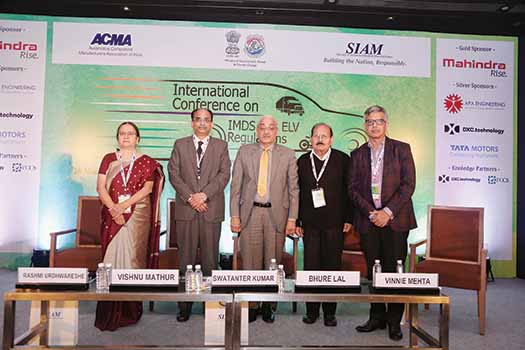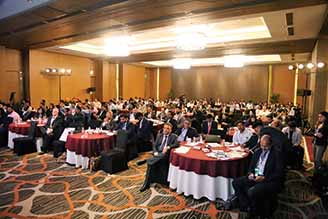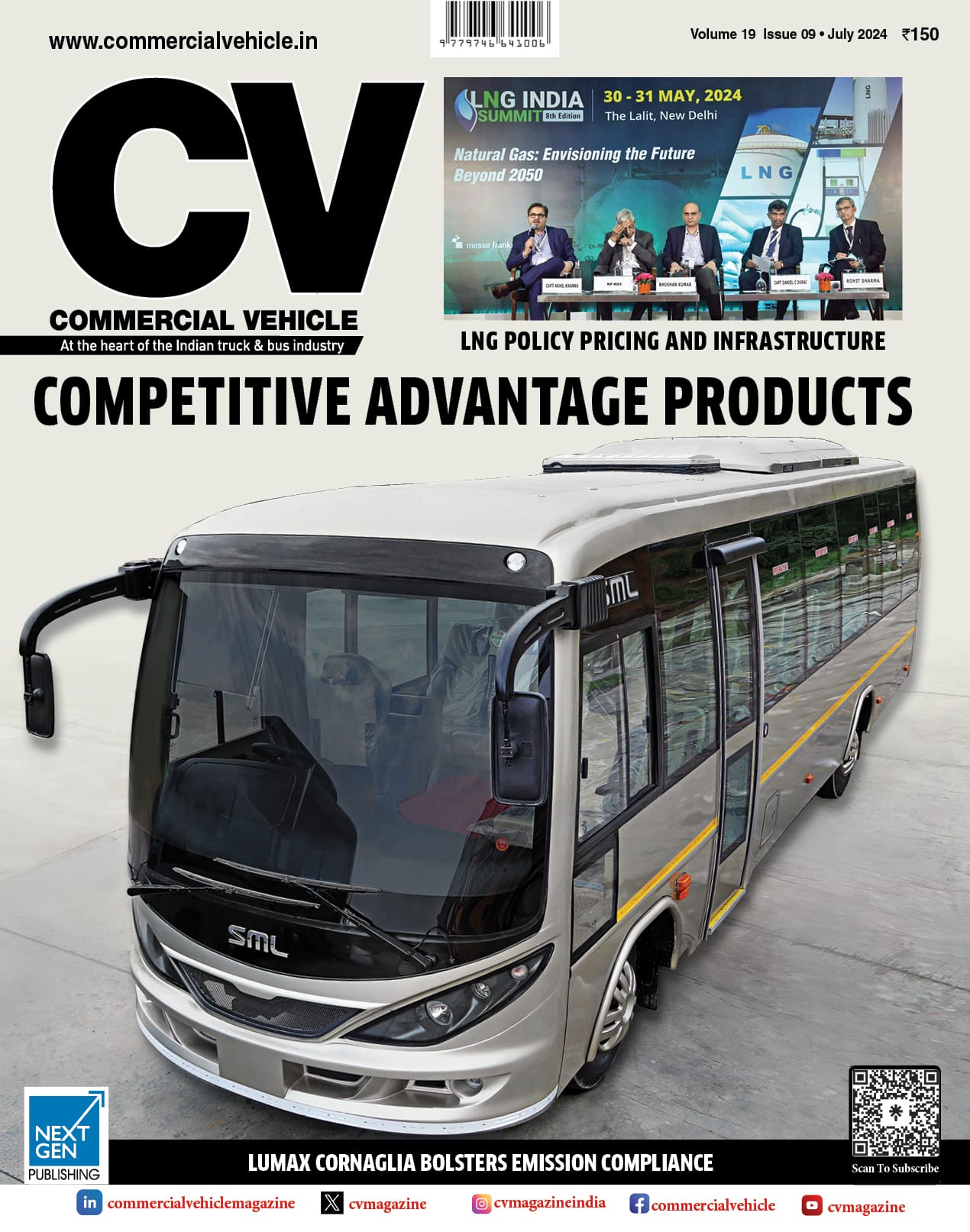Story by: Team CV
The way automobiles in India are disposed is far behind the scientific ways developed by many other automotive markets in the world. This includes CVs as well, which consist of a fair deal more metal and materials in terms of weight and quantity than a passenger car would. An event on automotive recycling by SIAM delved on environment friendly ways of disposal. It focused on sustainable material management and environmentally safe disposals. Attracting the participation of Ministry of Environment, Forest and Climate Change (MoEF & CC), Government of India, and Automotive Component Manufacturers Association of India (ACMA) apart from SIAM, the one-day event at Delhi titled, ‘International Material Data System (IMDS) and End of Life Vehicle (ELV) Regulations’, got industry stakeholders and experts to speak and discuss on numerous factors surrounding the scientific disposal of vehicles.

Claimed to be a first-of-its-kind initiative, the one-day conference saw experts focus on material management, tracking of hazardous chemicals, heavy metals, and Persistent Organic Pollutants (POPs) to minimise their negative impact on the environment and human health. Leading to the generation of data that would facilitate the automotive sector, regulatory agencies, R&D institutions and ministries to engage in further discussions and take actions under the Rotterdam and Stockholm Conventions, for which MoEF & CC is the nodal agency, the event saw Vishnu Mathur, Director General. SIAM, express the need to institutionalise automobile recycling in India and figure out methods to dispose ELVs in an environmentally friendly manner. “The purpose of this conference,” he mentioned, “is to increase knowledge, create awareness, build capacity and gain insights into IMDS and its regulations.” ARAI director, Rashmi Urdhwareshe, said that there was a need for an integrated approach towards clean air. “Fleet modernisation can improve air quality. Private car electrification and the banning of old vehicles are some of the solutions we can look at,” she averred. Stating that road and public infrastructure pose a serious concern, which must be addressed appropriately, Urdhwareshe said, “There should also be a control on the number of unused vehicles.”

Claiming that there are 35 million vehicles plying on roads that have already exceeded the age of 15 years, Rashmi Urdhwareshe explained that manufacturers must start using materials that are reusable. She urged the government to announce an ELV policy at the earliest. The ministry must notify AIS 129 standards immediately, she said. Drawing attention to the alarming rate at which vehicles are increasing and the pollution caused by them, Dr Bhure Lal, Chairman, EPCA, expressed the need to ensure sustainability of ecology and environment. Talking about ELV regulations, he mentioned, “We need a policy in place to discard old vehicles as it could pose difficulty in future for humans.” Justice Swatanter Kumar, Former Chairman, NGT, and former Judge, Supreme Court of India, averred, “There are enough laws for utilisation and dismantling of materials, and for controlling of vehicular pollution. The need is for policies to regulate the unorganised sector.” Stating that efforts are necessary to seek workable solutions for issues like vehicular emissions and their negative impacts on the environment, he spoke about a need to do wonders in controlling air pollution.
Stating that the automotive industry has been advocating vehicle scrappage since the past few years, Vinnie Mehta, Director General, ACMA, expressed a need to be more conscious towards environmental issues. “We’ll do our best to shield the future generations,” he said. Speaking during a technical session that saw many eminent speakers from the industry come together, Dr. Bharat Kumar Sharma, Additional Director, CPCB, Government of India, called for a need to manage, treat and dispose vehicles at their end-of-life in a proper manner. “This was necessary with the rapidly rising number of vehicles on the roads,” he said. Stressing upon the components posing an hazard to the enviornment, Dr. Sharma emphasised on the right approach to ensure sound environment friendly management of end-of-life vehicles. He drew attention towards the vehicle recycling sector lacking in such an approach. Speaking during the second technical session about implementation of relevant provisions of national and international regulations, Dr. Sharath Pallerla, Director, Ministry of Environment, Forest and Climate Change, explained the salient features and issues relating to the implementation of MSIHC rules, 1989, and HOW (M&TM) rules, 2016, in the automotive sector.

Expressing that the MSIHC rules, 1989, and HOW (M&TM) rules, 2016, apply to an industrial activity in which a hazardous chemical may be involved, Dr. Pallerla mentioned that it is important to deal with the safety and environmental aspects associated with hazardous chemicals in the automotive sector. This would help the authorities to be well-prepared in case of an emergency, he added. Dr. A N Vaidya from NEERI, Government of India, spoke in detail about the implementation and challenges of international obligations in the recovery and recycling of hazardous chemicals in the automotive sector. He mentioned that the automotive industry deals with many regulations, and there is a need to recognise the adverse impact of chemicals on the environment and human health, and take feasible actions to combat it. “The aim is to have international integrations in the recovery and recycling of chemicals in the automotive sector,” said Dr. Vaidya. He stressed on how the international regulations function under different annexures.
The third technical session on ‘Material Data Collection systems and ELV regulations globally,’ saw Dr. Rachna Arora, Deputy Team Leader and Coordinator, Internationale Zusammenarbeit (GIZ) GmbH, Paurnima Barve, Solution Leader RnDP-PAMDOC, Volvo Group, Nisha Ganesan, IMDS Coordinator, Fiat Chrysler Automobiles N.V., Dr Ishizuka Satoshi, Senior. Advisor, Maruti Suzuki India Limited, Sumit Issar, MD, Mahindra Intertrade, and S Shanmugham, Global Leader, Materials Technology, WABCO India, participate. The panel discussion on ‘IMDS Reporting and Challenges for Industry in India,’ attracted the participation of Frank Nottebom, Account Business Executive, DXC Technology, Shridhar Rajappanavar, Technical Head, PCCS, Rahul Lalwani, Senior Manager, Mahindra & Mahindra, Asmita Sathaye, DGM, Tata Motors Ltd., Ajith Kumar, Consultant R&D, TVS Motors and Sriniwas Raghavan, Material Science Expert, Brakes India.
Drawing attention to the rapid rise in the number of vehicles, Prashant K Banerjee, Executive Director (Tech), SIAM, expressed a need to improve the air quality. He stated that they were focusing on IMDS regulations and vehicle recycling against the backdrop of their rapid rise. Pointing at how the vehicle recycling industry was gearing up in India, Banerjee said, “With substantial increase in the number of vehicles in India, our objective is to improve the air quality by strictly adhering to IMDS regulations and vehicle recycling.” “Although it is being followed in many countries, there is a need to institutionalise the same in India,” he expressed. Stating that he is happy to see this event succeed, Banerjee said, “It is with this conference that we have set the stage for thought provoking discussions that would lead to solutions on vehicle recycling. It is certain to be a way of improving the air quality to a great extent,” he added.



























